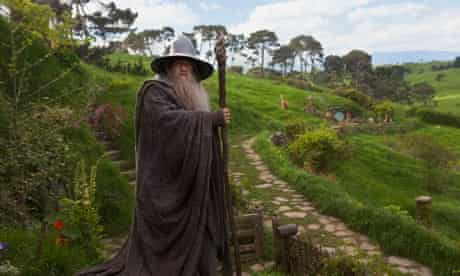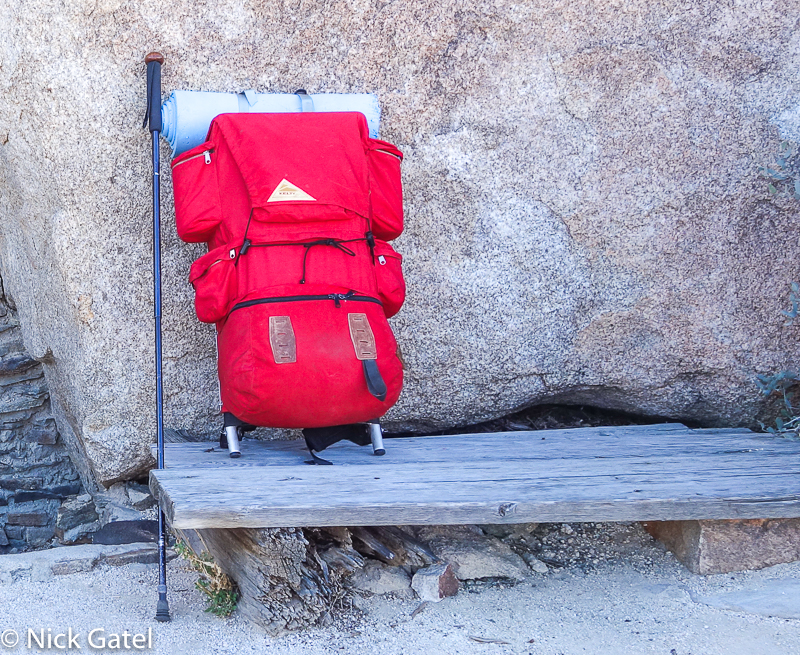Hiking staffs have been around for a long time. Moses used one to lead his people out of Egypt. Confronting Ramses, Moses transformed his staff into a snake and then back. He used it to produce water from a rock, and even used it to part the Red Sea. Try doing that with a set of trekking poles!!
A long, long, long time ago, Gandalf, the leader of the Fellowship of the Ring, had a staff, which was the source of much of his power.
The Hobbits and Aragorn weren’t traveling all over Middle Earth with trekking poles. They used hiking staffs!!
A long time ago, sometime in the ‘80s, I bought a Tracks Hiking staff. For its time, it was a high tech piece of equipment. I had never used a hiking staff before. This was in a time far, far, away; before trekking poles became part of the backpacker’s uniform.
At the time, hiking staffs were not popular. In fact they were kinda “dorky.” It was rare to see another hiker with a staff and trekking poles didn’t exist in the US.
Today trekking poles are common among hikers. I read a Wikipedia article that the Appalachian Trail Conservancy estimates that 90% of Appalachian Trail thru-hikers use trekking poles. I see people walking short flat trails of less than 3 miles, most of whom are using trekking poles and no pack. Yep, it’s a fashion trend. I tried trekking poles from about 2008 thru 2010. They didn’t help me at all, as I explained in this post eight years ago.
So why did I buy my hiking staff back in the ‘80s?
It was a period when I was doing a lot of desert exploring. I was spending a lot of time navigating slot canyons and boulder fields. The staff assisted me to keep my balance, while leaving one hand free. It could be adjusted into a short piece and strapped to my pack when I needed two hands to crawl up over boulders or shimmy down granite pour-overs.
And when I went up into the mountains, usually the Sierra Nevada, it helped me safely cross high streams and rivers.
Multi-use Features
It doubles as a pole for most of my shelters and can even convert a backpack into a nice chair.
Shelter Pole
Backrest

Camera Mount and Weapon/Hunting Tool
The walnut knob can be removed for duty as a camera monopod. The heavy-duty rubber tip can be removed to reveal a sharp point to harpoon fish and fight off evil spirits.
Other Benefits
It is excellent for moving large rattlesnakes out of my path. On long flat stretches of terrain it helps me keep my walking rhythm — just as well as the clickety, clackety trekking pole people. It is nice to lean on when stopping to absorb a great view, and helps keep me stable when walking ridgelines in big winds.
The neoprene grip is super-comfortable and has held up over the decades. It is durable – obviously. It is a two-section pole and uses a twist lock mechanism, like many trekking poles. But its locking mechanism is much better than similar trekking poles. I have never had to repair, clean, lube or otherwise do maintenance to the locking mechanism. And it hasn’t broken or need any repairs. The pole is spring-loaded. When I release the twist lock, the pole extends by itself.
Trekking Pole Experiment
In 2008 I bought a pair of trekking poles. They were a popular ultra light brand. Try as I might, I never warmed up to them. Reading up on the “proper” way to use trekking poles, I didn’t experience any real benefit as touted by the minions of trekking pole loyalists. These poles also had finicky twist-locks to adjust the pole height, which were always coming loose. Disassembling the poles, cleaning and lubricating the moving parts would get the twist-locks working for a few months. After a owning them for a couple years, I broke both of them one day on a steep 8,000 foot descent.
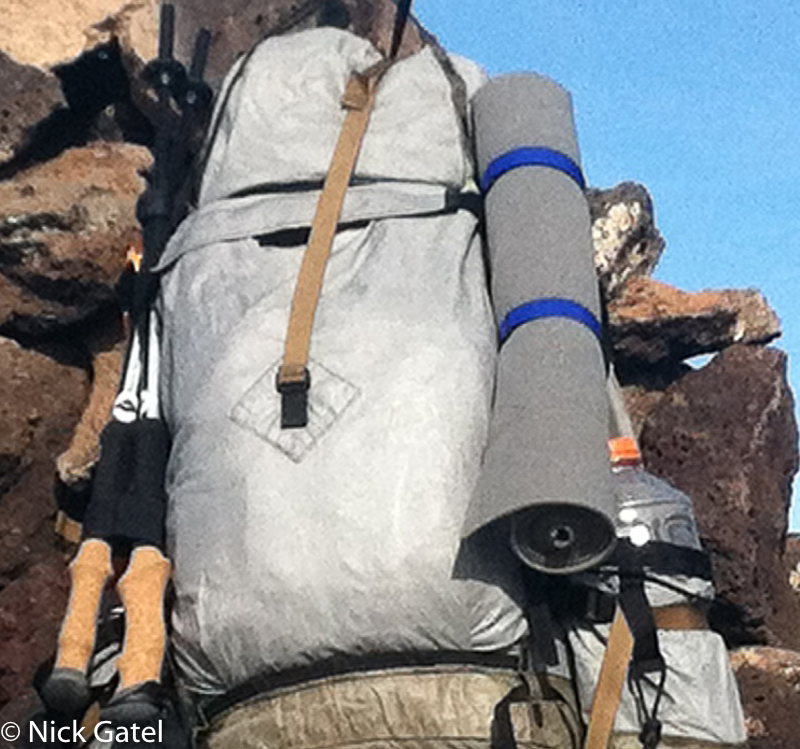
I went a head and purchased a new pair, Black Diamond Alpine Carbon Cork Trekking Poles. These are robust, well built, and have nice flip-lock adjustments.
I’ve quit using them for backpacking. I think I’ve used these trekking poles once since 2011 for backpacking. If you have to have a pair of trekking poles, I’d recommend these.
I do use them for snowshoeing, so I can’t say I have totally given up on trekking poles, but perhaps we can say I use ski poles, since I use these poles with snow baskets.
The trekking pole advocates swear they will save your knees, as you get older. I’m almost 70 years old, and having backpacked for over 50 of those years, not to mention all the running and basketball I’ve done over the years, I don’t have any knee of joint problems. Either I have great genes, or trekking poles aren’t the promised cure-all.
If you think you need trekking poles. Do your research. You may find them to be the “cat’s meow.” But you have to decide for yourself – don’t consider my point of view valid for you.
History of My Tracks Staff
When I purchased my Tracks Hiking Staff, a small company in Ferndale, WA manufactured them. Later Cascade Designs (owner of Mountain Safety Research; better known as MSR, and Therm-a-Rest air mattresses) bought Tracks. I used this hiking staff on almost every backpacking trip until around 2008. Then I had a brain-fart and bought a pair of trekking poles as I mentioned earlier, finally abandoning the trekking pole experiment after a couple years. For a short while, I just hiked without any kind of poles, as I did in the ‘60s and the ‘70s.
But at times I missed a hiking staff.
REI Four Winds Travel Staff
In 2012 I bought an REI Four Winds Travel Staff. A four-section pole, it telescoped down to 23 inches making it convenient to pack in checked airline luggage (most trekking poles cannot be carried on or stored in carry-on luggage due to the sharp point at the bottom).
The pole was made by Komperdell, a well known manufacturer of trekking poles, based in Austria.
The pole was too short when fully extended to 51 inches, the size of most adjustable trekking poles. Trekking poles and hiking staffs should be held with the forearm at a 90-degree angle at the elbow. Longer hiking staffs are convenient for doing other tasks, and many adjustable models expand to 57 or 59 inches. I would prefer a max length of 68-72 inches to accommodate the height need for a larger pyramid shelter, like the Chouinard Pyramid or Black Diamond Mega Light.
Having four sections, there are 3 twists locks that just invited problems, and since each section needs to have a smaller tube diameter than the one above it, in order to adjust, the pole felt flimsy and weak when hiking. I hated it and after just a few months, I retired it.
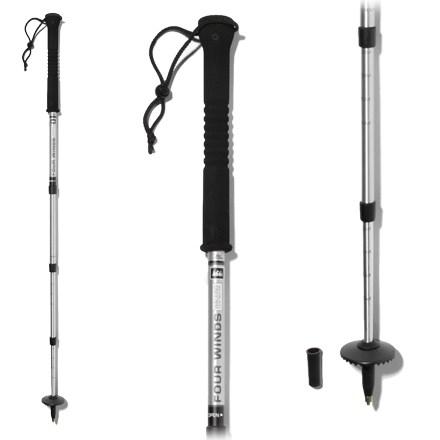
I should have just gone back to my Tracks Hiking Staff at this point. The Tracks, being a two-section pole, telescopes down to 33 inches, and was too large to pack on some of my airline trips. So I bought an REI Hiker Staff, also made by Komperdell.
REI Hiker Staff by Komperdell
This was much better. It has three sections, but extends to 57 inches, just two inches shorter than the Tracks, it has a similar grip, and the top can be unscrewed to expose a standard camera mount stud.
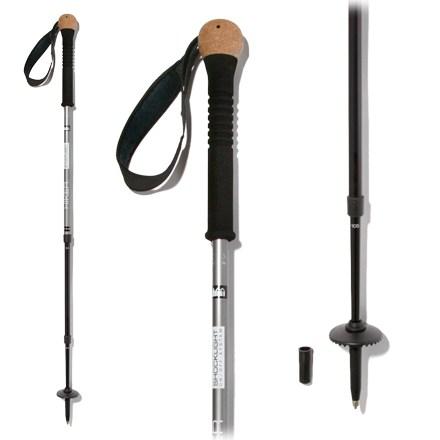
I used this for a couple of years, when I wanted a hiking staff, which wasn’t all of the time. Being a three-section pole, it has two twists locks, suffering the same problem as the four-section Four Winds staff, but not as severe.
But I missed the Tracks, which is a little more solid in use.
More and more I am taking the Tracks Hiking Staff on my trips, just as I did for over 30 years.


Where to Buy the Tracks Hiking Staff
A few years ago, Cascade changed the design, replacing the twist lock with a Push-button telescoping mechanism providing adjustment every 1-1/4″ – from 41 inches to 56 inches. Cascade named it the Tracks Sherlock Walking Staff.
Alas, you cannot buy either. Both the original and the update Sherlock have, as all good things are, been discontinued. I don’t know if Cascade made other kinds of poles, such as trekking pole, but I suspect they weren’t selling enough of the Tracks to make it worthwhile to continue.
An Option: The REI Hiker Power Lock Hiking Staff

However, REI now sells the Hiker Power Lock Staff, which looks identical to the REI Hiker Staff discussed earlier — this version has replaced the awful twist locks with flip power locks. It appears (do your research) to be the same or close to the Komperdell Camera Staff.
If you are interested in a hiking staff, taller than a trekking pole, which can be turned into a camera monopod, this may be the thing for you. These kinds of staffs are becoming more and more scarce.
This website contains affiliate links. I may receive a small commission at no cost to the reader if you purchase something via on of the links.

